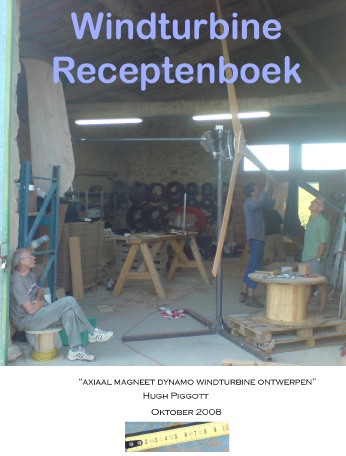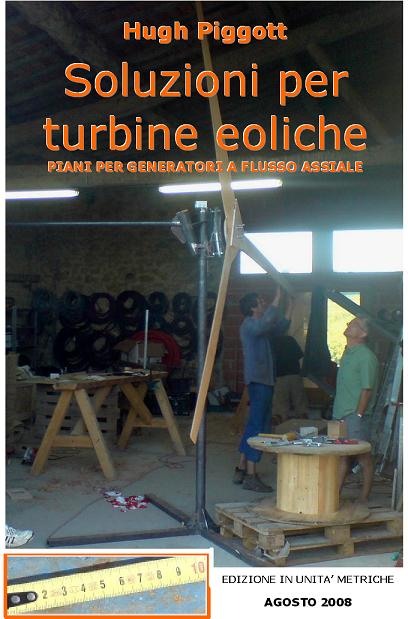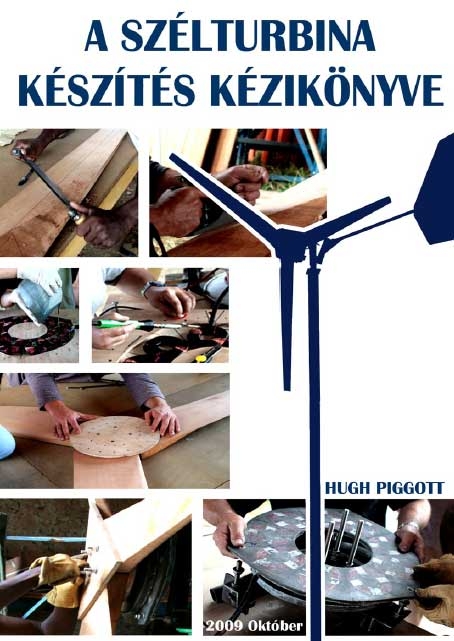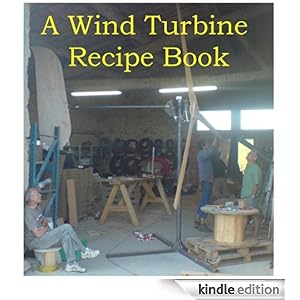The Wind Turbine Recipe Book is a 65 page document that takes you through the process of building your own wind turbine for battery charging. Six different sizes are described from 4 to 14 feet in diameter. Every detail of the construction is tabulated and illustrated, from the wooden blades to the purpose-built permanent magnet alternator. Only basic workshop tools and skills are required. These recipes have evolved from thirty years of living off-grid and building small wind turbines. Over the last ten years I have taught workshop courses worldwide, and these are the notes used in the courses. Groups have sprung up all over the world using these recipes to teach others the process. Many people also use the larger turbines for feeding directly into the grid with grid-tied inverters.
Click on a ‘buy now’ button below to order a physical book copy. The cost is US$26.17 including worldwide shipping. Delivery usually takes about five days. (Or you can get a pdf for $9.99 here.) The Inches edition of my Recipe book is intended for North American readers who will be using Inches for measurement, and AWG wire sizes. It is based on using magnets measuring 2″ x 1″ x 1/2″ that are readily available in America. Click the ‘buy now’ button below to order this book for delivery to America.
Click the ‘buy now’ button below to order the Metric Recipe Book using paypal or a credit card. This is the Metric edition using mm units and European wire sizes.
Windpower Workshop is my paperback book (189 pages) published by CAT in 2011.Click on the button below to buy this book using Paypal or a credit card. The cost including shipping is US$42.99.
“very informative, and easy to read” … “one of the most influential books of my high school career”
LINKS TO TRANSLATIONS OF THE RECIPE BOOK:
FRENCH, SPANISH, DUTCH
ITALIAN, GERMAN, HUNGARIAN
KISWAHILI

The Metric edition of the Recipe Book (2010) is available at low cost as a Kindle eBook from amazon.com (click the image below).









Hello,
I am looking for some material on how to make a wind turbine with drum brakes from Ford F-250. Could someone please contact me about where I could get the information or kit to construct one?
here is a link to a site where you can find my old brakedrum wind plans in the american edition for that size of hub
http://autonopedia.org/renewable-energy/wind-power/brakedrum-windmill-plans/#ford
It’s not what I would recommend nowadays but it worked well.
I think I can guess Hugh’s answer….
What cracks me up about crazy roof mounted systems is that for the expense and bother involved a few PV panels would always generate more power. They’re not always visible from the ground though, so aren’t flying a “look how green we are” banner for the building owner.
Hugh – I know from reading your blog you are not much on roof-mounted systems in general when better options exist.
Do you feel there is any long term potential on roofs, with improved efficiencies in vertical systems?
I am not sure how to answer this without being rude, but no I don’t see a solution that will make rooftop wind work. You can’t make power where there is none. This is what most people seem to be incapable of understanding. You can’t get solar power under a blanket. You can’t get windpower among buildings. You can measure the windspeed. The windspeed is very low and turbulent. This tells me that it’s not worth using it. End of story. Move on. Use solar PV instead. Put your wind turbine on a tall enough tower in clear enough wind to make it worth the effort.
I’m the energy specialist for Kawerak Inc., an Alaska Native non-profit in the Bering Strait Region of Western Alaska. I am working with 15 remote isolated Native Villages to help secure their energy future.
Each spring, everybody takes off to “fish camp” for a couple of months. I am doing a workshop called “Camp Energy” in hopes of showing folks ways to harness renewable resources while at camp. Most of our region has a good wind resource, and there is a lot of interest about wind. I purchased your book and look forward to reading it. If you have any materials or suggestions for my workshop I would appreciate your input.
Electricity averages .47 cents / kWh, and gasoline is more than $6.00 / gallon here today. More than 15,000 heating degree days per year. Do the math… renewable energy will pay for itself quickly here!
Cheers!